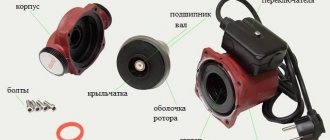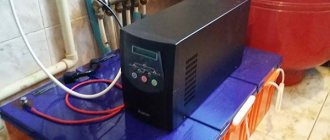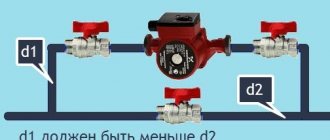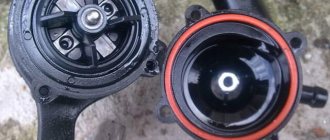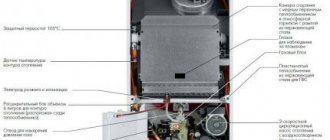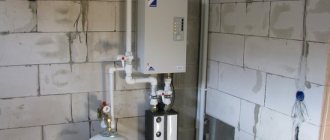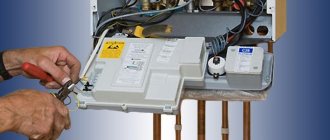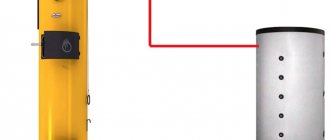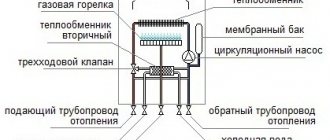The Wilo circulation pump in the Ariston double-circuit boiler ensures the supply of heated liquid to the heating radiators, cooling the primary heat exchanger, after dispensing hot water to protect the heat exchanger from the formation of scale on its internal walls.
Ariston boilers in the Genus Premium, Clas System, Genus, Clas models are equipped with a Wilo MTSL 15/5 HE - 2 circulation pump, its malfunction leads to an emergency stop of the heating device.
To repair the boiler circulation pump, you need to know its components. The working device includes the following components:
- housing with inlet and outlet pipes;
- rubber gasket;
- Electrical engine;
- turbine;
- plain bearings;
- fasteners;
- air vent;
- starting capacitor;
- control terminal.
The principle of operation of the circulation pump Wilo MTSL 15/5 HE - 2
The main part of the pump is an electric motor, consisting of a stator with several inductance coils to regulate the rotation speed, and a rotor, which is integrated on a shaft with bearings.
When power is applied to one of the stator windings, an electric field is created that drives the rotor with the turbine. The turbine blades capture fluid from the suction pipe and move it along the outlet pipe. In this way, the coolant circulates throughout the entire heating circuit.
Let's look at the main reasons leading to failure of the Wilo MTSL 15/5 HE - 2 pump.
Unstable voltage in the network
With reduced power, the pump motor slows down until it stops completely. With increased voltage, the inductor coils heat up, which can cause an interturn short circuit or burnout of the winding wire.
Contamination of pump mechanisms
When the liquid temperature is more than 60 ᵒC, scale may form on the turbine and shaft, which will slow down the rotation of the motor armature. Causes of pump jamming can also be increased oxidation of the driving mechanisms or the ingress of foreign objects.
Poor quality component material
If the pump uses parts made from low-quality materials, its service life is sharply reduced. For example, a shaft begins to jam due to the formation of a layer of rust on the surface of the bearings, because they are made of bronze, which contains iron. Such symptoms are typical for a non-original model.
Improper use of the device
Water through a working pump must constantly circulate at a certain speed. If the flow of the coolant is disrupted (the return or supply valve is closed, the system filter is clogged, etc.), the bearings and inductors in the device will overheat - this will lead to jamming of the rotor, breakage or short circuit of the stator winding.
The Wilo MTSL 15/5 HE - 2 circulation pump cannot be used when there is no water in the pipeline. But since Ariston double-circuit automatic units are equipped with liquid pressure sensors, the boiler will not turn on if there is no water in the system or its pressure is low.
What needs to be done to prevent the pump from breaking?
Wilo brand units are famous for their high reliability. However, they do not last forever and a simple failure to comply with the simplest operating rules can lead to partial or critical failure of the pump. You can extend the life of the unit by following several recommendations:
- It is strictly forbidden to run the pump “dry”;
- Do not block the flow of working fluid when the engine is running;
- When selecting power, it is important to calculate the minimum and maximum parameters;
- It is recommended to monitor the pressure in the housing, ensuring that it does not exceed the mark specified by the manufacturer;
- During long-term downtime, in order to avoid oxidation of components, it is advisable to start the unit for at least 10 minutes once a month;
- It is advisable to prevent foreign matter from entering the pump reservoirs using filters.
However, the main rule is that maintenance, including periodic replacement of consumables, must be carried out regularly.
Electrical repair
The electrical part of the pump includes the following components:
- inductor;
- starting capacitor;
- connecting wires;
- control terminal.
If the stator winding breaks down, the pump becomes unrepairable; all other components can be repaired or replaced. To analyze the condition of electrical parts, you will need an ohmmeter.
Photo of the circulation pump Wilo MTSL 15/5 HE – 2.
Main symptoms of malfunction
If the boiler display shows an error code corresponding to a water circulation problem, and it is not reset, the problem may be hidden in the electronic part of the device.
Circulation pump with cover removed.
To identify the problem you must:
- Turn off the heating mode in the boiler, and after stopping all components, turn off the power (soft stop).
- Open the front panel of the case.
- If the pump is covered with a large layer of dust, clean its surface.
- Using the information in the diagram, remove the control terminals and remove the terminal with the capacitor.
- Visually examine the condition of the pump contacts and terminals; they should be free of oxides, burnouts and mechanical damage.
- Using a tester in diode testing mode, determine the integrity of the connecting wires that go from the control board to the pump.
- Use an ohmmeter to determine the resistance of the inductors. On a working device, the instrument readings on the contacts will correspond to the following values:
- No. 1, 4 – 150 – 160 Ohm;
- No. 1, 6 – 290 – 300 Ohm;
- No. 2, 3 - 0 (contacts connected together);
- No. 3, 5 – 220 -230 Ohm;
- No. 4, 6 – 150 – 160 Ohm.
- The device will be considered faulty if the ohmmeter reading on any of the above pair of marks is 1 (winding wire break) or 0 (short circuit, except for contacts 2,3).
- Check the condition of the starting capacitor. To do this, switch the tester regulator to the 20 microfarad capacity test mode. Connect the probes of the device to the terminals of the capacitor and determine its capacitance. It should match the nominal ± 10%. Loss of capacity leads to a decrease in pump performance; it will emit an uncharacteristic hum.
Electrical diagram of the pump Wilo MTSL 15/5 HE – 2.
Measuring the resistance of the circulation pump windings.
How circulation pumps are designed and work
The operating principle of circulation pumps is not much different from the design of drainage models. The device body is made of durable materials that are resistant to corrosion. Typically this is stainless steel, aluminum, brass, cast iron. When started, the engine begins to rotate a rotor equipped with an impeller. As a result, the pressure at the inlet pipe decreases and water is sucked into the hydraulic chamber. The rotation of the impeller creates centrifugal force. Water is pressed against the walls of the chamber and forcefully thrown into the pipeline through the outlet. This ensures forced circulation of the coolant in a closed heating circuit.
Installation diagram of the circulation pump via bypass
Design differences between different types of devices
There are two main types of pumps - with “wet” and “dry” rotors. The “wet” rotor is separated from the water by special sealing rings, between which there is a thin film of water. When worn, the rings wear out and are pressed closer to each other, which guarantees the tightness of the structure for several years. Cooling and lubrication are provided by the working fluid. Pumping equipment of this type is installed in systems with small coolant volumes, because It is difficult to ensure tight connections in large-diameter structures. When installing devices, it is important to ensure that the shaft is positioned strictly horizontally, otherwise the device may malfunction.
The main advantage of “dry” models is their high efficiency. It is 80%, which distinguishes it favorably from the 50% efficiency of “wet” type devices. The rotors of “dry” heating circulation pumps do not come into contact with the liquid. Depending on the location of the engine, structures are divided into horizontal (cantilever), vertical and block. All “dry” models are noisy during operation and are sensitive to the quality of the coolant and air purity. It is advisable to install them in separate rooms of boiler rooms, controlling the purity of the water in the system and the air in the room.
Design of a household circulation pump for heating
Mechanical repair
All other parts that are not listed in the section: “Electrical repair” refer to mechanical components. If vibration or noise occurs in a running pump, to determine the source of its occurrence it is necessary:
- Stop the boiler smoothly.
- Remove the front panel of the housing and lower the control unit.
- Close the cold water, supply and return taps.
- Drain water from the boiler system through the drain valve.
- Unscrew the pump air vent lock to completely drain the water from the system. After all the fluid has been drained, tighten the lock until it stops.
- Remove the terminal with the starting capacitor.
- Unscrew the fastening screws and remove the motor-turbine unit.
- Inspect the bearings, impeller, and pump cavity for oxidation, contamination, foreign objects, and damage. If there is wear on the bearings or the motor shaft rotates with force, then they need to be replaced with others, for example, fluoroplastic ones. All dirt from the turbine, internal compartments of the housing, and sealing rubber should be removed.
- Place the repaired mechanism in place and secure it.
- Insert the terminal with the capacitor.
- Open the return, supply and cold water taps.
- Using the make-up tap, check the pump for leaks; if it does not leak, then add coolant to the system up to 1.2 bar.
- Start the pump in circulation mode and check its condition.
- If the results are positive, set the heating circuit temperature control knob to the required position.
The service life of the Wilo circulation pump and other boiler components can be extended if full maintenance is carried out before each heating season.
Preventive measures
Preventive measures help extend the service life of the pumping unit and prevent premature breakdowns. Every user can perform such actions without contacting specialists. However, if the device is under warranty, then servicing can only be performed by a technician from a specialized company. Otherwise, the seller's or manufacturer's warranty will be void. In general, you need:
- • inspect the pump 4-5 times a year;
- • Clean internal elements 4-5 times a year.
The duration of operation may be affected by the quality of the coolant and the conditions under which the plumbing/heating system operates. In addition, pay attention to:
- • tightness of connections;
- • serviceability of grounding;
- • presence of extraneous sounds when turning on the device;
- • presence of vibration;
- • indicator of existing pressure;
- • the housing, which must be dry and clean.
Read here Peach color in the interior: its features and a small collection of 90 photos
As a rule, Wilo pumps are made to be reliable, wear-resistant and durable. Therefore, they do not require investment over many years of operation.
Video: professional flushing of the heating system
If the circulation pump gets hot, the reasons can be very different. Do not rush to dismantle the device. First, measure the voltage in the network. If it is normal, flush the system with caustic soda, filling it for at least an hour, and then draining the solution. If this does not help, contact a specialist, otherwise the device will burn out and you will have to buy a new one, because rewinding the motor windings can be more expensive.
They very rarely break. But if there are any malfunctions, you should seek help from a specialist. But in order to prevent equipment malfunctions, it is necessary to periodically check its operation and monitor the serviceability of all pump elements.
Why does the circulation pump heat up - the main reasons
Ideally, the pump temperature should be the same as the coolant pipes. If it is higher, it means that either errors were made in the installation, or there are problems with operation. Typically, the circulation pump of the heating system gets hot for the following reasons:
- Incorrect installation. The easiest way to determine the presence of installation errors is: the device begins to overheat at the initial stage of operation of the heating system.
- Clogged system. Over time, various deposits and rust accumulate in the pipes. This leads to a narrowing of the water passage diameter. The pump has to work at increased load to push the coolant into the narrowed pipes, and the electric motor overheats. Preventive measures will help “cure” it - unscheduled maintenance of the heating system.
- Foreign body. If communications are slagged, pieces of rust or limescale may come off the internal surfaces of pipes and radiators. When they get into the pump, they jam the electric motor. The result is usually predictable: if you do not disassemble and clean the device in time, the motor coils will fail.
- Lack of bearing lubrication. If it is not enough, the bearings wear out much faster, which shortens the service life of the entire device as a whole. The engine jams. It is advisable to dismantle the pump and take it to a workshop.
- Low voltage in the network. If the voltage is below standard 220 V, the engine overheats and quickly fails. At the first signs of overheating, it makes sense to determine the voltage in the network using a voltmeter. Perhaps the problem is not in the pump itself.
Do-it-yourself preventative cleaning of batteries
